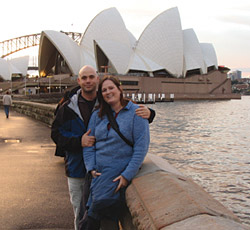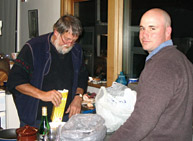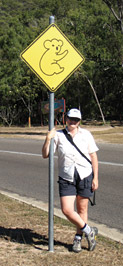Traveling Out of the Comfort Zone
Traveling Out of the Comfort Zone McGill University
User Tools (skip):
Traveling Out of the Comfort Zone

James Caddell and Tara Newell in front of the Sydney Opera House.
Tara Newell, BA'98, and James Caddell, BA'97, are a couple of adventurous grads who embarked this summer on a two-year global trek, determined to take life as they find it and to experience the local culture in every country they visit. They've kept in touch with the News during their travels and James sends the following early dispatch from the edge.
After a year and a half of saving every penny, purging our possessions, quitting our stable government jobs and leaving our comfortable Ottawa apartment, my wife Tara and I set off on a trip around the world. While our friends were starting families in their newly acquired four-bedroom houses, we were becoming hobos, left with nothing but what was in our backpacks. We wondered if we were totally insane, but we knew that a journey across six of the world's continents would provide us with an experience no university or employer could.

James with Simon Firth preparing the shark Tara caught for dinner, in Hobart, Tasmania.
We both received BAs from McGill in political science and history. McGill was good to us, providing opportunities to achieve broader educational goals: Tara was president of the Students' Society in 1997-98 and I was able to take a year off school in 1995 to serve a tour as a UN peacekeeper in Bosnia. These experiences, combined with a couple of MAs, led us to successful careers working for the federal government. I was a senior advisor in the Canada Student Loans Program and Tara was the manager of Ministerial Support for the National Secretariat on Homelessness - both programs were part of Human Resources Development Canada. Our lives were moving on a fast track, so why exchange this up-and-coming existence for a life of being unemployed and homeless? Our educations had illustrated how diverse the world was, but we knew that we were living in just one tiny corner, enclosed in a secure and comfortable bubble. We wanted to break out, so the idea for the trip was born.
We started planning in the fall of 2002, roughly ten seconds after we returned from our honeymoon in Africa, where one small event profoundly affected us. While on our way to a national park in the north of Kenya, our Land Rover broke down in a tiny community of a few mud houses near the base of Mount Kenya. We'd been warned to avoid such impoverished communities for fear of being robbed. However, once stranded, we set out to explore while waiting for our driver to figure out (along with a growing group of local men) how to fix a broken radiator cap without any parts or tools.

The next few hours became the most memorable experience of our trip - hanging out with the local children who followed us around and who seemed never to have seen white people before. They wanted to touch us, put their hands through Tara's hair, explore the contents of our pockets and just be near us. They were completely enthralled, and so were we. After a cap from an old water can was jerry-rigged with duct tape (my suggestion, since all Canadian soldiers learn that anything can be fixed with duct tape), the truck was ready and we set off for the park. Our happy accident made us realize that there were worlds outside of package tours that we wanted to explore.
Our new itinerary grew to include North America, Australia, Southeast Asia, the Indian subcontinent, the Middle East, Africa, Europe and South America. Our savings would allow us a budget of $100 CDN per day in the U.S., Australia and Western Europe, and $50 per day in developing countries. We knew that living on so little would be a challenge, but we thought with a sense of adventure, a little creativity, and plenty of peanut butter and jelly sandwiches, we could make it around the world before the money ran out.
Other than stretching our Canadian dollar to the limit, our most important goal was to avoid exchanging one comfortable bubble for another - the tourist bubble. The tourist is comfortable on organized tours, eats familiar foods, and stays in approved hotels, while the traveler lives with locals, eats indigenous cuisine, and avoids the beaten path.


